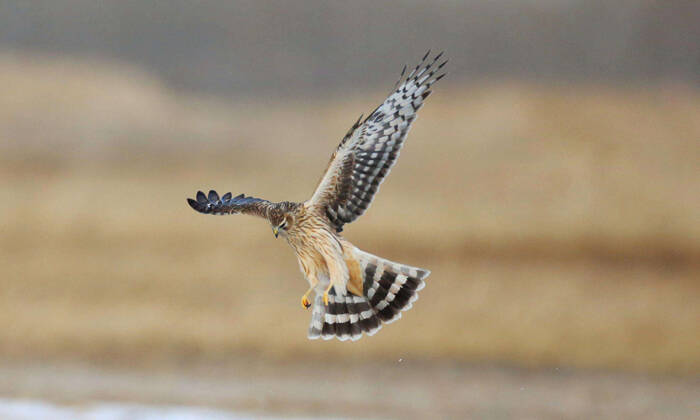Circus cyaneus
IUCN
LCBasic Information
Scientific classification
- name:Circus cyaneus
- Scientific Name:Circus cyaneus,Hen Harrier,Gray Harrier, Gray Hawk, White-clawed Harrier, Gray Harrier, Chicken Bird
- Outline:Raptor
- Family:Falconiformes Accipitridae Harriers
Vital signs
- length:45-53cm
- Weight:310-600g
- lifetime:8-16years
Feature
When gliding, the two wings are raised up to form a "V" shape
Distribution and Habitat
Origin: Afghanistan, Albania, Algeria, Antigua and Barbuda, Armenia, Austria, Azerbaijan, Bahamas, Bangladesh, Barbados, Belarus, Belgium, Belize, Bhutan, Bonaire, St. Eustatius and Saba, Bosnia and Herzegovina, Bulgaria, Cambodia, Canada, Cayman Islands, China, Colombia, Costa Rica, Croatia, Cuba, Curacao, Cyprus, Czech Republic, Denmark, Dominican Republic, Dominican Republic, Egypt, El Salvador, Estonia, Finland, France, Georgia, Germany, Gibraltar, Greece, Grenada, Guadeloupe, Guatemala, Haiti, Honduras, Hungary, India, Iran (Islamic Republic of), Iraq, Ireland, Israel, Italy, Jamaica, Japan, Jordan, Kazakhstan, South Korea, North Korea, Kuwait, Kyrgyzstan , Lao People's Democratic Republic, Latvia, Lebanon, Libya, Liechtenstein, Lithuania, Luxembourg, Macedonia, Malta, Mauritania, Mexico, Moldova, Mongolia, Montenegro, Montserrat, Morocco, Myanmar, Nepal, Netherlands, Nicaragua, Norway, Oman, Pakistan, Palestine, Panama, Poland, Portugal, Puerto Rico, Qatar, Romania, Saint Ki
Appearance
The male White-tailed Harrier has a grey-white forehead, a gray-brown head with dark feather trunk lines, a dark brown back with brown feather edges, and a ruff formed by a circle of fluffy and slightly curled feathers from the back to the bottom of the ear feathers. The neck is blue-grey, often decorated with brown or yellowish-brown feather edges. The back, shoulders and waist are blue-grey, sometimes slightly tinged with brown. The upper tail coverts are pure white; the central tail feathers are silver-gray with inconspicuous horizontal spots, the next two pairs are blue-grey with dark gray horizontal spots, and the outer tail feathers are white with dark gray-brown horizontal spots. The upper wing coverts are silvery gray, the outer 1-6 primary flight feathers are dark brown, the base of the inner feathers is white, the outer feathers edge and tip are gray, the remaining primary flight feathers, secondary flight feathers and tertiary flight feathers are all silver gray. The inner f
Details
The white-tailed harrier, also known as Hen Harrier, is a medium-sized bird of prey with two subspecies.

The white-tailed harrier is a summer migratory bird in Northeast China and western Xinjiang, a winter migratory bird in the middle and lower reaches of the Yangtze River, the southeast coast, southern Tibet, Yunnan, and Guizhou, and a migratory bird or an occasional winter migratory bird in other places, including Hong Kong and Taiwan. It migrates to the breeding grounds in Northeast China in spring from late March to early April, and leaves the breeding grounds in October-November.
The white-tailed harrier often flies low along the ground, frequently flapping its wings, and flies extremely agilely and quickly, especially when chasing prey. Sometimes it glides over the grass, with its wings raised in a ‘V’ shape, moving slowly, and shaking its wings from time to time, with its wings slightly bent backwards when gliding. Sometimes it rests on the ground and watches the activities of prey in the grass.
The white-tailed harrier mainly feeds on animal food such as small birds, rodents, frogs, lizards and large insects. It is active and forages during the day, especially in the morning and dusk. It mainly hunts on the ground. It often flies low along the ground in search of prey, and quickly descends to the ground to hunt after finding it.
The breeding season of the white-tailed harrier is from April to July. In the early breeding period, it is common to see pairs flying in the air for courtship and chasing each other. The nest is built on the ground between dead reeds, grass or shrubs. The nest is mainly composed of dead reeds, cattails, and twigs. It is shallow and disc-shaped, with a diameter of 30-50 cm and a height of 5-11 cm. Each nest lays 4-5 eggs, occasionally as few as 3 and as many as 6. When the eggs are just laid, they are light green or white, with cinnamon or reddish brown spots. The size of the eggs is 44-56 mm × 34-40 mm, with an average of 48.5 mm × 37.3 mm, and weighs 27-40 grams, with an average of 33 grams. After the first egg is laid, the female bird begins to incubate the eggs, which last for 29-31 days. The chicks are late-maturing and have short white down feathers when they are just hatched. Usually, the female bird warms the chicks in the nest in the first few days after hatching, while the male bird goes out to forage and feed the chicks. After two or three days, the female bird also participates in the chick-rearing activities. After 35-42 days of nesting, the chicks can leave the nest.
Listed in the "Red List of Endangered Species of the World Conservation Union" (IUCN) 2016 ver 3.1-Least Concern (LC).
Listed in the "Washington Convention" CITES Appendix II protected animals.
Listed in the list of China's national key protected wild animals, a national second-level protected animal.
Protect wild animals and stop eating game.
Maintaining ecological balance is everyone's responsibility!








